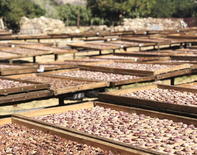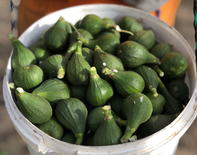The ‘eating fig’ is a popular fruit for eating fresh, as dried fruit or for use in jams, chutneys and desserts. It is produced in over 50 countries worldwide, and grows well in warm and dry yet temperate areas of South Africa.

Recently, dark-coloured figs are surging in popularity. Cooling technology has helped to improved the shelf-life of fresh figs, and the export of South African figs with airfreight has contributed to a continued export product, during the months of November/December to April/May. A niche market for baby figs from South Africa, of the variety Evita (Great Parisian), is growing.
The History of Figs
Figs may have originated in Western Asia and can be traced back to about 5000 B.C. They spread with travellers and was introduced into the UK, China and Europe in the 1500s.
In the 1800s they were planted on farms and in gardens in South Africa but were not commercially farmed until the start of the 1900s. In the 1910s Piet Cilliers imported plant material from California and planted the first commercial fig orchard on his farm in Wellington in the Western Cape. The fig industry initially focussed on drying figs and fig jam and grew with the commercial production of jam and the processing of green figs (breba figs).
It was only in the early 2000s that the production of fresh figs for the eating market started in South Africa with the export to the UK and European supermarkets.
International Fig Production
More than 1 million tonnes of figs are produced in more than 50 countries worldwide. The main fig producer is Turkey, which produces about 26% of the world’s production. Their main cultivar is ‘Black Bursa’ a large black-skinned fig with a long shelf-life. Turkey is also the main producer of dried figs.
Other fig-producing countries are Egypt, Algeria, Tunisia and Morocco in Africa as well as Syria, the USA, Brazil, Spain and Iran.
South African Fig Production Areas

South Africa has 222 hectares planted to commercial fig production (2019).
The warm dry summers of the arid Klein Karoo region is most suitable for ripening figs, but figs in South Africa are planted in various regions.
These include the Swartland area (Porterville, Riebeeck Valley, Malmesbury and Hermon), Paarl, Worcester, Napier in the Overberg and in the Klein Karoo (Kammanassie area near Oudtshoorn and Prince Albert). T
he town of Bonnievale produces green figs - also called breba figs - for preserves and there are some plantings in the North-West Province near Rustenburg, Brits and Magaliesberg. Dedicated drying of ‘White Genoa’ and ‘Adam’ fig varieties is done in Prince Albert.
Fig Production Season
The fig season in South Africa starts with the harvesting of breba figs in November to about mid-December. Breba figs are figs that develop on the previous season’s shoots. Varieties that produce these early figs are ‘Adam’, ‘White Genoa’ and ‘Dauphine’.
The main fig harvest starts in January with the tiny Ronde de Bordeaux, beginning of January to March, and then Tangier is harvested from mid-January to February. The season ends with Parisian, which also starts in mid-January and ends in April.
Fig Sales in South Africa
According to the Department of Agriculture, Forestry and Fisheries (DAFF) the total production of fresh figs in South Africa is around 2 000 tonnes per year from 2013/2014 up to 2017/2018. Of this, about 10% is sold fresh to local South African markets and another 12% - 13% is processed.
According to Hortgro, South Africa exported 380 tons of figs in the 2017/18 season, which is about 0.12% of the world’s figs. The main importing countries for South African figs are the UK, Hong Kong and the Netherlands.
By Marinda Louw
For bulk or Fig export enquiries please use the enquiry link below.